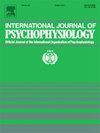聆听心跳慢速和快速心跳声的行为和神经生理学相关性。
IF 2.5
3区 心理学
Q3 NEUROSCIENCES
引用次数: 0
摘要
背景研究发现,聆听心跳声会影响心脏活动和行为。然而,人们对这些刺激对大脑活动和认知的影响却知之甚少。α振荡(8-13赫兹)被认为是大脑皮层激活的标志。额叶α不对称(FαA)反映了刺激的价值以及接近/回避刺激的倾向。目的:本研究调查了不同节奏的模仿心脏搏动的声音对反应时间和神经生理活动的影响:方法:在静息状态和两个简单反应时间任务(SRT)中收集脑电图数据,在这两个任务中,人工产生了快节奏(120 bpm,FastBeat 条件)或慢节奏(60 bpm,SlowBeat 条件)的心跳声。对三种条件下的α功率进行了比较。研究了快拍(FastBeat)和慢拍(SlowBeat)条件下 SRT 和 FαA 值的差异:结果:与静息状态相比,在两种任务中均观察到双侧前中枢区域的阿尔法活动减少。对快拍(FastBeat)和慢拍(SlowBeat)条件进行比较后发现,前者的反应时间更快,右额叶区域的α抑制模式更明显,FαA值更低:在静息状态和两种任务条件的比较中引起的阿尔法抑制的相似性表明,这些模式可归因于两种条件(SRT 任务、听觉刺激)的共同过程。相反,两种条件之间的差异表明,快速心跳声被认为是更加不利和紧张的刺激,会诱发与消极状态和回避倾向相关的皮层激活。本文章由计算机程序翻译,如有差异,请以英文原文为准。
Listen to the beat: Behavioral and neurophysiological correlates of slow and fast heartbeat sounds
Background
Listening to heartbeat sounds have been found to affect cardiac activity and behavior. However, less is known about the effects of these stimuli on brain activity and cognition. Alpha oscillations (8–13 Hz) are considered markers of cortical activation. Frontal alpha Asymmetry (FαA) reflects the valence attributed to the stimulus and the tendency to approach/avoid it.
Aim
This study investigates the effects of sounds mimicking heart pulsations at different rhythms on reaction times and neurophysiological activity.
Method
EEG data were collected during a resting-state condition and two Simple Reaction Time tasks (SRT), during which artificially generated heartbeat sounds at fast (120 bpm, FastBeat condition) or slow (60 bpm, SlowBeat condition) rhythms were administered. Alpha power was compared across the three conditions. Differences in the SRT and FαA values were examined between the FastBeat and SlowBeat conditions.
Results
Compared to the resting-state condition, decreased alpha activity over bilateral frontocentral regions was observed in both tasks. The comparison between the FastBeat and the SlowBeat conditions revealed faster response times, a pattern of alpha suppression over right frontal regions, and lower FαA values in the former.
Conclusions
The similarity of alpha reductions elicited in the comparison between the resting-state and the two task conditions suggests that these patterns were ascribable to processes common to both conditions (SRT task, auditory stimulation). In contrast, the differences between the two conditions suggest that fast heartbeat sounds are perceived as more adverse and stressful stimuli, inducing cortical activation over regions associated with negative states and avoidant tendencies.
求助全文
通过发布文献求助,成功后即可免费获取论文全文。
去求助
来源期刊
CiteScore
5.40
自引率
10.00%
发文量
177
审稿时长
3-8 weeks
期刊介绍:
The International Journal of Psychophysiology is the official journal of the International Organization of Psychophysiology, and provides a respected forum for the publication of high quality original contributions on all aspects of psychophysiology. The journal is interdisciplinary and aims to integrate the neurosciences and behavioral sciences. Empirical, theoretical, and review articles are encouraged in the following areas:
• Cerebral psychophysiology: including functional brain mapping and neuroimaging with Event-Related Potentials (ERPs), Positron Emission Tomography (PET), Functional Magnetic Resonance Imaging (fMRI) and Electroencephalographic studies.
• Autonomic functions: including bilateral electrodermal activity, pupillometry and blood volume changes.
• Cardiovascular Psychophysiology:including studies of blood pressure, cardiac functioning and respiration.
• Somatic psychophysiology: including muscle activity, eye movements and eye blinks.

 求助内容:
求助内容: 应助结果提醒方式:
应助结果提醒方式:


